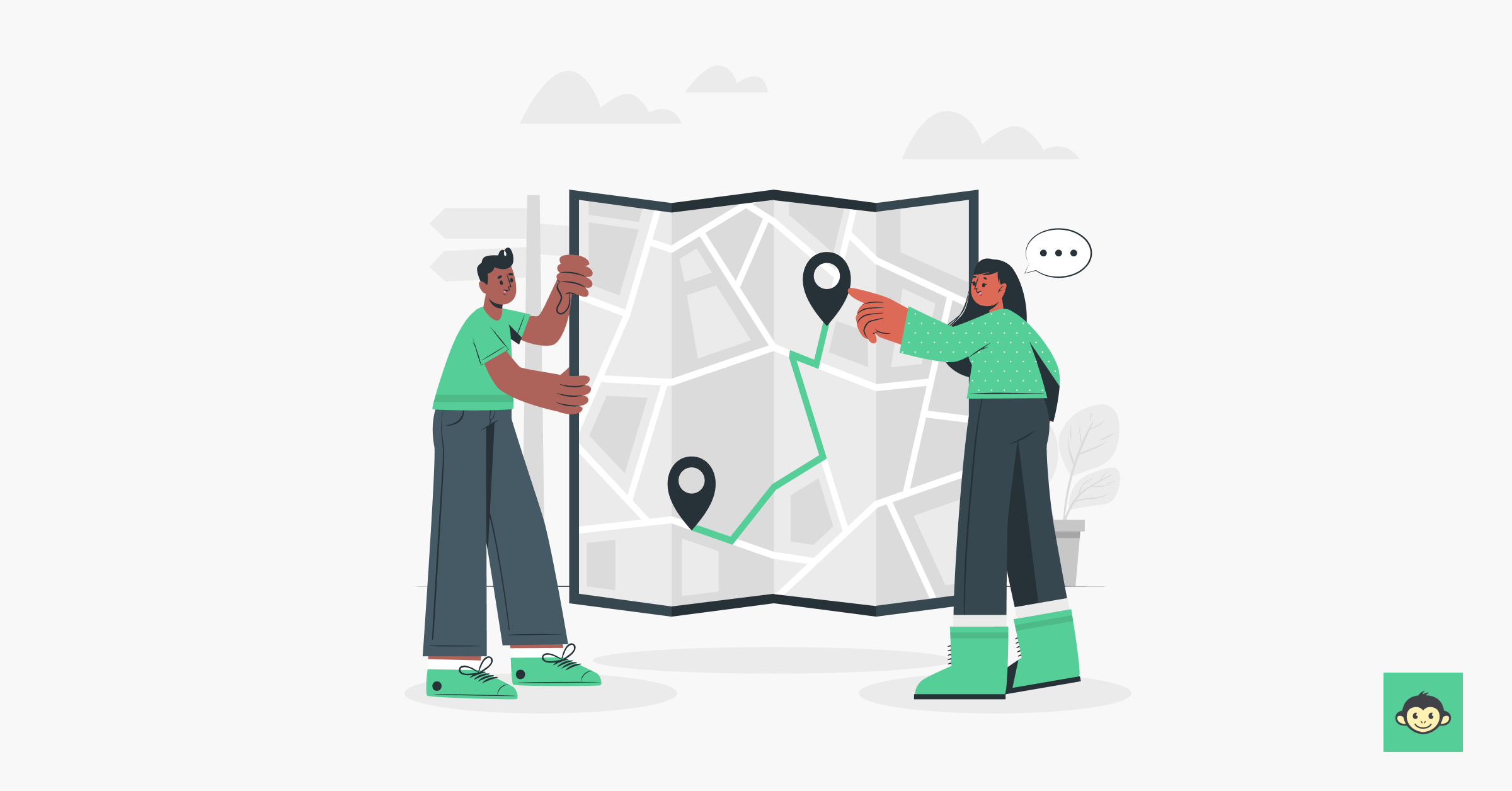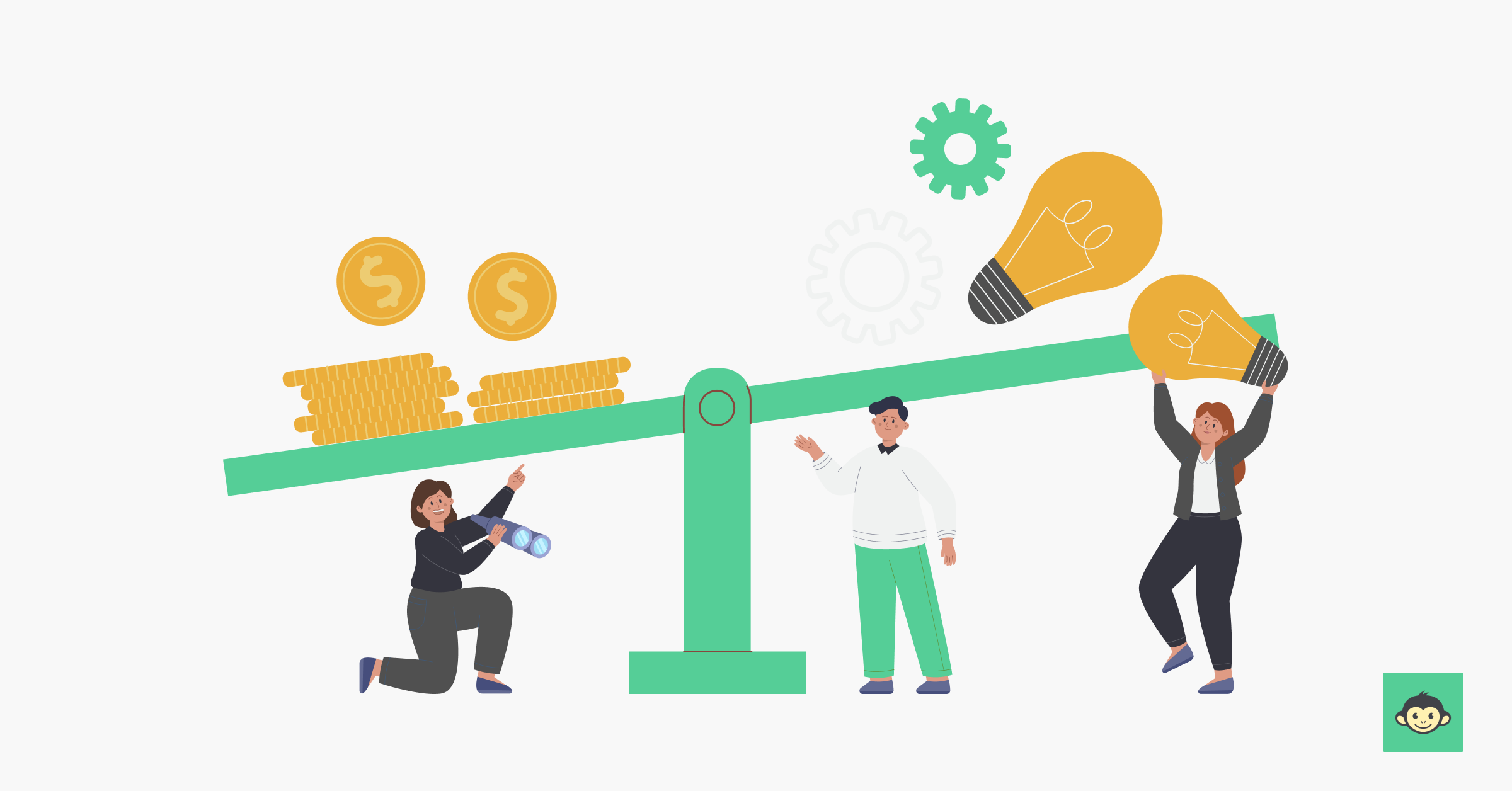Employee experience journey mapping - A complete guide

Employee experience journey mapping might sound like a mouthful, but it's basically just a fancy way of saying, "Let's figure out what our employees are going through and how we can make it better."
It's like a treasure map, but instead of gold, we're searching for how to make employees happy throughout. But why??
As the entrepreneur and businessman J. Willard Marriott once said, ”Take good care of your employees, and they'll take good care of your customers, and the customers will come back.”
So sit back, relax, put on your adventure hats and grab a cup of coffee (or your preferred beverage of choice) because we are about to explore the employee experience journey, dream up ways to make it better, and discover the secrets of mapping out this process.
Table of contents:-
- What is the employee journey?
- What is employee journey mapping?
- What are the benefits of employee journey mapping?
- How an employee journey map can help you
- Employee onboarding journey map
- How to leverage employee journey mapping to create value
- The dos and don'ts of employee journey mapping
- What are the stages of the employee journey?
- What is employee experience?
- What is an employee experience journey?
- Four steps for mapping the employee experience
- How do you create an employee experience journey map?
- Personas for employee journey mapping
- The employee journey from the employee’s perspective
- Employee journey mapping touchpoints
- Common mistakes that companies make while mapping employee journey
- How CultureMonkey can improve the employee experience?
What is the employee journey?

Every employee goes through a unique journey in your company, from their first day of onboarding to the last day they walk out the door. But have you ever thought about what that journey looks like? And more importantly, have you thought about how you can improve it?
An employee journey can make all the difference in retaining top talent, boosting employee engagement, and improving productivity. In fact, studies have shown that companies with a strong focus on employee experience outperform their competitors by 122%. So, why aren't all companies putting more focus on the employee journey?
Employee journey mapping is a process of identifying all the touchpoints and interactions an employee has with your company, from the moment they apply for a job to their last day in the office.
A positive employee journey can lead to more engaged and productive employees. When employees feel supported and valued, they're more likely to go above and beyond in their work. And that's a win-win for everyone.
What is employee journey mapping?

Employee journey mapping is the process of mapping out all the touchpoints an employee has with your company, from their first day of onboarding to their last day in the office.
It's a way of understanding and improving the employee experience by mapping out their interactions with the company from the moment they first hear about the organization as a potential employer to their eventual departure.
But why should you care about employee journey maps? For one, it helps you identify pain points in the employee experience that could be driving employees away. Maybe your onboarding process is too lengthy, or your employees aren't getting enough feedback or recognition for their hard work.
It helps organizations develop a comprehensive and holistic view of the employee experience, which is critical for improving employee engagement and retention.
What are the benefits of employee journey mapping?
Employee journey mapping is like a treasure map, leading you to a trove of benefits. It's a strategic tool that enhances every aspect of your organization, from employee satisfaction and productivity to attracting and retaining top talent.
With a well-crafted journey map, you're on the path to creating a workplace where everyone thrives, and success is just around the corner.
- Enhanced productivity: A well-designed Employee Journey Map helps streamline processes and remove obstacles that can hinder productivity. When employees encounter fewer roadblocks and can navigate their roles more efficiently, they become more productive. This not only benefits your employees but also positively impacts the bottom line.
- Increased retention rates: High employee turnover can be a significant drain on resources. Employee journey mapping helps create a supportive and fulfilling work environment. When employees feel well-integrated and valued, they're more likely to stay with your organization. Lower turnover rates mean cost savings in recruitment and training.
- Talent attraction: A positive Employee Experience Journey becomes a magnet for top talent. Word-of-mouth recommendations from your content employees can be a powerful recruitment tool. A great reputation for employee experience can draw in the best and brightest in the industry.
- Clearer communication: Mapping out the journey helps identify communication gaps. Effective internal communication is key to a successful organization. By understanding where the challenges lie, you can implement strategies to improve communication, ensuring everyone is on the same page.
- Enhanced employee development: Through journey mapping, you can pinpoint opportunities for skill development and growth at every stage of the employee experience. This encourages continuous learning and personal development, which can lead to higher job satisfaction and career advancement.
- Better decision-making: Employee journey maps provide valuable data and insights. With this information, you can make informed decisions about the employee experience. Whether it's resource allocation, policy changes, or organizational improvements, you have a clear path to follow.
- Strengthened company culture: Mapping the employee journey allows you to align every stage with your company's values and culture. It's an opportunity to ensure that your culture is not just a buzzword but a real, living experience for your employees.
How an employee journey map can help you

By gaining a deeper understanding of the employee journey and identifying pain points and opportunities for improvement, organizations can increase employee engagement and retention rate, which can lead to a more productive and successful workforce.
Here are some other key reasons why you should be focusing on mapping out the employee journey in your company:
Improves employee experience:
By mapping out the employee journey, you can identify pain points and areas where improvements can be made. This helps create a more positive, supportive work environment that retains top talent.
Increases employee engagement:
When employees feel supported and valued, they're more likely to go above and beyond in their work. Mapping out the employee journey and addressing pain points can help increase employee engagement and motivation.
Boosts productivity:
A positive employee journey can lead to more engaged and productive employees. By addressing pain points and creating a more positive work environment, you can improve productivity and drive success.
Improves retention:
Retaining top talent is crucial for the success of any company. By creating a positive and supportive work environment through employee journey map, you can reduce turnover and retain top performers.
Enhances employer branding:
A positive employee journey can also enhance your employer branding. When employees feel supported and valued, they're more likely to share their positive employee experiences with others, both online and offline. This can help attract top talent and improve your company's reputation.
Provides valuable insights:
Employee journey mapping provides valuable insights into the employee experience. By understanding employees' touchpoints and interactions with your company, you can identify patterns and trends that can inform future decisions and improvements.
Fosters a culture of continuous improvement:
Employee journey mapping is an ongoing effort to identify pain points and make improvements. By fostering a culture of continuous improvement, you can create a workplace that's always striving to be better.
Expedites onboarding:
When you map the employee journey, it significantly accelerates the onboarding process. New hires can seamlessly navigate through their initial days, feeling more integrated and confident from the get-go.
Promotes inclusivity:
Employee journey mapping also fosters inclusivity. It ensures that the employee experience is uniform and supportive across various departments and roles, creating a workplace where everyone feels equally valued and respected.
Strengthens leadership development:
Your journey map can become a powerful tool for leadership development. By recognizing the stages where leadership plays a vital role, you can tailor training and support to nurture the next generation of leaders within your organization.
Enhances well-being initiatives:
A well-crafted employee journey map integrates well-being initiatives. This ensures that employees are not only professionally fulfilled but also mentally and emotionally supported, resulting in a healthier and happier workforce.
Employee onboarding journey map

Picture this: You've just welcomed a talented recruit to your team. What's next? The employee onboarding journey map is your treasure map, guiding you through the intricate process of making them feel right at home.
So, what exactly is an employee onboarding journey map? It's like a step-by-step guide, detailing the entire onboarding process, from pre-hire to post-orientation. It's a strategic approach that ensures your new team members embark on a voyage of learning, growth, and engagement.
The journey begins with pre-boarding, where you start connecting with your new hires before their first day. Then, there's the orientation – the grand "Welcome Aboard" moment. After that, it's all about training, skill development, and team assimilation. Finally, the journey continues with regular check-ins and performance evaluations.
Creating a tailored journey map is the key to employee retention and productivity. It ensures everyone's on the same page, expectations are clear, and the road to success is well-paved.
How to leverage employee journey mapping to create value

Understanding how to make the most of employee journey mapping is essential for modern HR professionals and business leaders. In this guide, we'll explore not only the fundamental steps in leveraging this tool but also delve into additional ways to extract maximum value from it.
Here are some key ways to leverage employee journey mapping to create value!
Identify key touchpoints
The first step in leveraging the employee journey map is to identify the key touchpoints in the employee experience. This includes everything from recruitment to onboarding, training, performance review/management, and offboarding.
Collect data
Once you've identified the key touchpoints, it's time to collect data on the employee experience. This can include employee feedback, employee surveys, and data on employee turnover, productivity, and employee engagement.
Analyze the data
After collecting data, it's important to analyze it to identify pain points and areas where improvements can be made. Look for patterns and trends that can inform future decisions.
Map out the journey
Once you clearly understand the employee experience, it's time to map out the journey. This can be done using a variety of tools, such as journey maps, employee personas, and empathy maps.
Identify opportunities for improvement
With the employee journey mapped out, it's easier to identify areas where improvements can be made. Look for pain points and areas where the employee experience could be improved and prioritize the most critical ones.
Implement changes
Once you've identified areas for improvement, it's time to implement changes. This can include everything from streamlining the recruitment process to improving communication and recognition programs.
Continuously monitor and improve
Employee journey mapping is not a one-time process. It's important to continuously monitor the employee experience and make improvements as needed. This can include collecting ongoing feedback from employees, analyzing data, and making changes to improve the employee experience.
Enhance training and development
The employee journey map can highlight specific points where training and development play a crucial role. Use this information to revamp training programs, offer skill-building opportunities, and ensure that employees have the resources they need to succeed.
Facilitate cross-department collaboration
Employee journey mapping can uncover areas where different departments need to collaborate more effectively. Foster a culture of cross-departmental teamwork to eliminate silos, improve communication, and enhance the overall employee experience.
Customize employee experiences
Tailor the employee experience based on individual preferences and needs. Use data from the employee journey map to offer personalized career paths, flexible work arrangements, or unique benefits, providing employees with more customized experiences.
Implement recognition and rewards
Recognize and reward employees for their contributions at key touchpoints in the employee journey. Acknowledging their achievements can boost motivation and job satisfaction, leading to a more positive overall experience.
The dos and don'ts of employee journey mapping

Employee journey mapping is a potent tool for creating a fulfilling, engaging workplace. If you follow the dos and avoid the don'ts, you're on the right path to crafting an experience that keeps your employees happy, productive, and loyal.
The Dos: Crafting a stellar employee journey map
- DO understand your employees: Before you even put pen to paper or fingers to the keyboard, take the time to truly understand your employees. Gather insights through employee engagement surveys, interviews, and feedback. Recognize their needs, desires, and pain points, and ensure these insights drive your map.
- DO define clear stages: Your map should be divided into clear, distinct stages. Start with the recruitment phase and then move through onboarding, professional development, and everyday work experiences. Clearly define the key milestones in each stage.
- DO include employee input: Employee involvement is paramount. Encourage your employees to participate in the mapping process. They can provide invaluable insights into their experiences and suggest improvements that can make the journey more engaging and fulfilling.
- DO align with company culture: Each stage of the journey should be intricately woven into your company's culture and values. It's crucial that employees feel connected to your organization's mission and vision throughout their journey.
- DO keep it dynamic: Employee journey mapping isn't a one-and-done exercise. It's a living, breathing document that should evolve with time. Regularly assess the effectiveness of each stage and make adjustments based on employee feedback and changing needs.
- DO measure outcomes: Establish key performance indicators (KPIs) to gauge the success of your employee journey map. Are employees more engaged? Is turnover decreasing? Are you attracting top talent? Use measurable outcomes to evaluate the map's effectiveness.
The don'ts: Pitfalls to avoid
- DON'T make it too complex: Simplicity is your best friend. Avoid overcomplicating the mapping process. Keep it clear and easy to understand so that everyone in your organization can follow and benefit from it.
- DON'T neglect employee feedback: If you're not actively seeking employee input, you're missing out on a goldmine of insights. Neglecting their feedback can lead to an inaccurate representation of their experiences and needs.
- DON'T stick to the status quo: An employee journey map isn't effective if it merely replicates current processes. Don't be afraid to challenge the status quo and make necessary changes for a better employee experience.
- DON'T forget continuity: The journey shouldn't end with onboarding. It's a continuous process, and all stages should seamlessly connect. Don't isolate the onboarding process from daily work experiences; instead, ensure a smooth transition.
- DON'T set it in stone: An inflexible map can become a hindrance. Don't treat your employee journey map as a final, unchangeable document. Embrace adaptability and be open to refining and adjusting the journey as your organization grows.
- DON'T ignore data: Ignoring data is one of the gravest mistakes you can make. Employee journey mapping relies on insights and measurable outcomes. Neglecting the data you gather can lead to a skewed perception of your employees' experiences.
What are the stages of the employee journey?

Here are the stages of the employee's journey, in brief:
- Application: If potential employees decide your organization is the right fit, they will typically apply for a position. This involves submitting a resume or application and potentially going through pre-employment screening and assessments.
- Interview: After submitting an application, the potential employee may be invited to interview for the position. This stage involves assessing the candidate's fit for the role and evaluating their skills and experience.
- Onboarding: If the candidate is selected for the position, they will move into the onboarding stage. This involves training and orientation to the company culture, policies, and procedures for the new employee.
- Development: Once an employee is onboarded, they will move into the development stage. This involves ongoing training and development to improve their skills and advance their career.
- Performance: The performance stage involves ongoing performance management, including setting goals, providing feedback, and evaluating performance.
- Recognition: Employees thrive on recognition, and it's important to make it a key stage in the employee journey. This includes both formal recognition programs and informal feedback and praise from managers and colleagues.
- Retention: The retention stage is where employees decide whether they want to stay with the organization or leave. During this stage, it's important to provide a positive workplace culture that values and respects employees.
- Career advancement: In the career advancement stage, employees seek opportunities for growth within the organization. This may involve taking on more responsibilities, pursuing promotions, or exploring lateral moves to develop new skills and expand their career horizons.
- Wellness and well-being: As employee well-being becomes a focal point for many organizations, a dedicated stage for wellness initiatives is crucial. This stage involves supporting employees' physical and mental health, providing resources for work-life balance, and promoting a culture of well-being.
- Separation: Finally, the separation stage involves an employee leaving the organization, whether voluntarily or involuntarily. This can involve offboarding, exit interviews, and evaluation of the employee's tenure with the company.
By understanding the stages of the employee journey, people leaders can better identify pain points and opportunities for improvement and create a positive and productive workplace culture that drives success.
Whether you're just starting or have been in the game for years, taking a strategic approach to the employee journey is key to achieving your HR goals. So, get out there and prioritise the employee journey in your organization.
What is employee experience?

So, what exactly is employee experience (EX)? In a nutshell, it's the collective impression your employees have of their time at your company. It's the sum of every interaction, from the first "You're hired!" to the farewell handshake. It's the vibe, the culture, the perks, and the way you support their growth.
Think about it. Imagine two companies side by side. One treats its employees like cherished family members, nurtures their talents, and offers a fantastic work environment. The other is all about squeezing every drop of productivity, ignoring well-being.
The first one? That's the kind of employee experience that leaves employees excited to show up each day. It fosters loyalty, sparks innovation, and boosts performance. The second one? Well, let's just say it might struggle with high turnover and disengaged employees.
Creating a positive employee experience isn't just a "nice-to-have" anymore; it's a strategic imperative. It involves understanding your team's needs, fostering a vibrant company culture, and investing in their development and well-being.
The key takeaway here is that employee experience goes way beyond the paycheck. It's about nurturing a work environment that makes people thrive, fosters their happiness, and, in return, drives your organization to greater heights.
What is an employee experience journey?

The journey typically kicks off with the very first encounter, the recruitment phase. From there, it's a thrilling ride through onboarding, professional development, and everyday work experiences. It's the highs and lows, the laughter and challenges, all rolled into one grand story.
Creating an exceptional employee experience Journey isn't just a buzzword. It's a strategic move that can set your company apart. When your employees feel valued, engaged, and appreciated, they become your best brand advocates, boosting your reputation and attracting top talent.
Imagine your workplace as a theme park – you're the designer, and the employees are your guests. You get to create the rides, attractions, and overall ambiance. The more memorable and enjoyable the journey, the longer they'll stay on this thrilling ride with your company.
In a nutshell, the employee experience Journey is all about crafting a remarkable, fulfilling adventure for your employees. So, let's embark on this journey of creating a workplace where everyone feels like they're in the heart of an exhilarating adventure!
Four steps for mapping the employee experience

Mapping the employee experience is your secret recipe for a workplace where employees thrive and businesses flourish. So, get ready to set sail on this transformative journey to create an exceptional workplace experience.
Step 1: Define the stages
Begin by breaking down the employee journey into stages. Start with the recruitment and onboarding phase, move on to professional development, and finally, the ongoing work experience. Each stage has its unique challenges, goals, and opportunities to shape the employee's experience.
Step 2: Employee insights
Next, gather insights directly from your employees. Conduct surveys, interviews, and feedback sessions. Ask about their aspirations, and pain points on moments that matter to them. This not only helps you understand their perspective but also makes them feel heard and valued.
Step 3: Design the experience
With a deep understanding of each stage and employee insights, it's time to design the experience. This involves creating a clear path with defined touchpoints. For example, in the onboarding phase, ensure a warm welcome, comprehensive training, and a buddy system for support. Tailor each stage to align with your company's culture and values.
Step 4: Continuous improvement
The employee experience Journey isn't set in stone. It's a dynamic process that requires continuous improvement. Regularly assess the effectiveness of each stage, gather feedback, and make necessary adjustments. This keeps your experience fresh, relevant, and aligned with your employees' evolving needs.
How do you create an employee experience journey map?

Creating an employee experience journey map can be daunting, but it doesn't have to be. With a little bit of planning and organization, you can create an effective employee journey map that will help you improve the overall employee experience in your organization.
Here are 5 pointers on how to create an employee experience journey map:
- Define your employee personas: To create an employee journey map, you need to understand your employees. Start by defining your employee personas. These are fictional representations of your employees based on characteristics such as their job title, department, age, gender, and experience.
- Visualize the journey: Create a visual representation once you've mapped out the employee journey. This can be a flowchart, a timeline, or any other visual that helps you understand the journey.
- Set goals: Set specific, measurable goals for improving the employee experience. This could include reducing turnover, increasing employee engagement, or improving the employee onboarding process.
- Develop a plan: Once you've identified areas for improvement and set goals, develop a plan to achieve them. This may involve making changes to processes, implementing new technologies, or providing additional training to employees.
- Test: Implement your plan and test the changes you've made to the employee experience. Collect feedback from employees to ensure that the changes are having a positive impact.
By following these 5 pointers, you can create an effective employee journey map that will help you identify areas for improvement and set goals to achieve them. Remember to continuously monitor and improve the employee experience to ensure that your organization is providing the best possible environment for its employees.
But what are the personas of employees?
Personas for employee journey mapping

Personas play a crucial role in employee journey mapping as they help create a clear picture of the employees going through different journey stages. A persona is a fictional character that represents a group of employees with similar goals, needs, and behavior patterns.
Creating personas for employee journey maps is crucial in ensuring you accurately map the employee experience.
Here are some pointers to create personas for employee journey mapping:
- Research: Start by researching your employees and gathering data on their needs, behaviors, and pain points. You can collect this data from surveys, interviews, and focus groups.
- Segment your employees: Based on the data collected, segment your employees into different groups with similar needs, behaviors, and pain points.
- Give them a name: Once you have segmented your employees, give each group a name that represents them.
- Create a backstory: Create a backstory for each persona that outlines their journey, starting from their first interaction with the company to their current stage.
- Identify their goals: Identify the goals and motivations of each persona. This will help you map out the touchpoints that can help them achieve their goals.
- Understand their pain points: Identify the pain points for each persona. This will help you map out the touchpoints that can alleviate their pain points.
- Add a face: Add a visual representation to each persona to make them feel more real.
- Use personas to create empathy: Use personas to create empathy among the team and to help them understand the needs and pain points of different employees.
- Continuously update personas: The needs and behaviors of employees change over time, so it’s important to continuously update your personas to ensure they accurately represent your employees.
- Use personas to guide decision-making: Use personas to guide decision-making throughout the employee journey mapping process. This ensures that decisions are made considering the employee’s needs and pain points.
By using personas, you can create a more accurate and empathetic employee journey map that will help you improve the overall employee experience.
The employee journey from the employee’s perspective

Have you ever thought about the employee journey from the employee's perspective?
As people leaders, it's important for us to put ourselves in our employees' shoes and understand how they experience their journey within the company.
From the day they first apply for a job to their last day of work, every touchpoint an employee has with the organization can impact their overall experience. This includes the hiring process, onboarding, performance evaluations, and even their exit interview.
As employees, they want to feel valued, respected and appreciated for the work they do. They want to feel like they're part of a team that is working together to achieve common goals. They want to have the resources and support they need to perform their job to the best of their abilities.
However, there are also challenges that employees face, such as navigating complex processes, dealing with office politics, and managing work-life balance. These challenges can impact employee engagement, motivation, and overall employee satisfaction with their job.
By listening to our employees' feedback and concerns, we can identify areas of improvement and make changes to enhance their journey within the organization. This benefits the employees and leads to increased productivity, retention, and a better company culture overall.
Employee journey mapping touchpoints

"It's not the destination, it's the journey"? Well, in the world of employee experience, that journey is known as the employee journey map. And just like any journey, it's made up of various touchpoints that shape an employee's experience.
What are these touchpoints, you may ask? They're every interaction an employee has with the company, from the moment they first hear about the job opportunity to the day they leave the company. These touchpoints can be divided into three categories:
- Pre-hire touchpoints: This includes any interaction the employee has with the company before being hired, such as the application process, interviews, and pre-employment testing.
- Core touchpoints: These are the primary interactions employees have during their employment, including onboarding, training, performance reviews, and development opportunities.
- Post-employment touchpoints: Even after an employee leaves the company, there may still be interactions to consider, such as exit interviews, alumni networks, or opportunities for rehiring.
- Culture integration touchpoints: Culture integration touchpoints involve the ways employees become acclimated to the organization's culture. For example, this could include participation in company-wide events, team-building activities, or orientation sessions that emphasize the company's values and mission.
- Employee wellness program touchpoints: Employee wellness programs are a crucial touchpoint for promoting the well-being of your workforce. This includes initiatives like offering fitness classes, mental health resources, or wellness challenges that encourage a healthy lifestyle.
Some examples of specific touchpoints to consider at each stage include:
- Pre-hire: Job postings, career fairs, recruiter emails, initial phone screens, skills assessments, and reference checks.
- Core: Onboarding materials, orientation sessions, team introductions, benefits enrollment, regular check-ins with managers, skills training, and company events.
- Post-employment: Exit surveys, alumni networks, rehiring programs, referrals, and employee retention programs to keep former employees engaged and connected to the company.
- Culture integration: As part of culture integration touchpoints, you could organize regular team-building events, such as off-site retreats or virtual team-building activities, to help employees connect with their colleagues and foster a sense of camaraderie.
- Employee wellness programs: Wellness challenges, such as step competitions or nutrition initiatives, can encourage a healthy lifestyle, allowing employees to engage with and benefit from the company's wellness program.
By considering each touchpoint in the employee journey, companies can gain valuable insight into areas where they can improve the employee experience and opportunities to retain top talent and create a more positive workplace culture.
Common mistakes that companies make while mapping employee journey

Employee journey mapping is a powerful tool to improve the overall employee experience and to identify areas for improvement in the HR department.
However, not all companies get it right. Here are some common mistakes that companies make while mapping the employee journey:
Skipping important touchpoints
Companies often forget to include critical touchpoints in the employee journey. These touchpoints can be small but essential in shaping the employee experience. For example, companies may forget to include touchpoints such as job offer acceptance, onboarding, or the first 90 days of employment.
Not involving employees
Employee journey mapping should be a collaborative effort between HR and employees. However, companies often forget to include employees in the process. By not involving employees, companies miss out on valuable insights that can help improve the overall employee experience.
Focusing on the positives only
Employee journey mapping should include both positive and negative experiences. Companies often make the mistake of only focusing on positive experiences, such as promotions or salary increases. However, it's equally important to identify negative experiences such as difficult coworkers, lack of recognition, or inadequate training.
Not linking to business outcomes
Employee journey mapping should be linked to business outcomes, such as employee engagement, retention, and productivity. Companies often forget to measure the impact of employee journey mapping on these critical business outcomes.
Assuming one size fits all
Employee journey map should be tailored to the needs of different employee personas. Companies often make the mistake of assuming that one size fits all. However, the employee experience varies based on the job role, department, and location.
Not prioritizing improvements
Employee journey maps should not just be a one-time exercise. Companies often make the mistake of not prioritizing improvements based on the impact they will have on the overall employee experience. Identifying quick wins and prioritizing improvements based on their impact on business outcomes is essential.
Not measuring success
Employee journey maps should be measured to track progress and identify areas for improvement continually. Companies often make the mistake of not measuring success, which makes it difficult to assess the impact of the employee journey map exercise.
Overcomplicating the process
Employee journey mapping should be a clear and straightforward process. However, some companies make the mistake of overcomplicating it with excessive detail or complex tools. This can lead to confusion and make it challenging to implement improvements effectively.
Neglecting technology
In the digital age, technology can streamline the employee journey mapping process and make it more accessible. Neglecting to use digital tools or software can be a significant oversight, as it can make data collection and analysis more efficient.
Lack of consistency
Consistency is crucial in mapping the employee journey, but some companies make the mistake of varying their approach for different departments or job roles. This inconsistency can result in an unequal employee experience, leading to disparities in engagement and satisfaction.
Not addressing turnover
Some companies focus solely on the current workforce and overlook the importance of understanding the journey of employees who have left the organization. Analyzing the reasons for their departure can provide valuable insights for reducing turnover in the future.
Ignoring the remote work experience
With the rise of remote work, it's essential to include touchpoints related to the remote employee experience in your journey map. Companies that fail to do this miss the opportunity to create a holistic employee journey that considers the unique needs of remote workers.
Companies need to avoid these common mistakes to create an employee journey map that truly reflects the employee experience and drives real results for the business.
How CultureMonkey can improve the employee experience?

Well, well, well, folks! We’ve come to the end of our journey mapping adventure. It’s time to put those maps to use and transform the employee experience. But wait, before you go, let me summarize the highlights of our journey together.
Firstly, we learned what employee journey mapping is and how it can improve the overall employee experience. We also explored the different stages of the employee journey and how to create an employee journey map.
We didn't forget about personas and how to incorporate them into our journey maps to make the employee experience more personal and relevant.
But wait, what about the mistakes companies often make? We can't forget those. We talked about the common mistakes companies make when mapping employee journeys so that you can avoid them and create a successful journey map.
Now, here’s where CultureMonkey comes in. The platform has everything you need to create a seamless employee experience journey map. With CultureMonkey, you can collect anonymous feedback at every stage of the employee lifecycle, identify gaps in your employee experience, and take action to improve the overall employee experience.
CultureMonkey offers a wide range of features, including pulse surveys, manager effectiveness surveys, eNPS, onboarding surveys, exit surveys, employee engagement surveys, and much more. With all these tools at your fingertips, you can take control of the employee experience and transform it into something amazing.
So there you have it - a complete guide to employee experience journey mapping. So take the time to understand their journey and use that knowledge to create a workplace they love. Happy mapping!
Employee experience journey mapping FAQs
How to design an employee journey map/Steps to create an employee journey map
To design an employee journey map, you should begin by identifying the employee journey stages, including pre-hire, onboarding, development, and separation. Then, create a list of touchpoints or interactions that an employee has with the organization at each stage. Finally, gather employee feedback through surveys, interviews, and focus groups to better understand their experiences.
What is experience journey mapping?
Experience journey mapping is the process of creating a visual representation of a person's journey as they interact with a company. It involves identifying all the touchpoints and interactions a person has with a company and mapping them out to understand the experience. The goal of experience journey mapping is to identify pain points and opportunities for improvement.
Is Journey Mapping an Agile approach?
Employee Journey Mapping is not necessarily an Agile approach but can be used in Agile methodology. It involves visualizing an employee's experience with the organization and identifying touchpoints where the company can improve the employee's experience. The Agile approach focuses on iterative and collaborative work to deliver value to the end-users.
What is the difference between workflow and journey map?
A workflow is a visual representation of a specific process, while an employee journey map is a comprehensive illustration of an employee's overall experience within the organization. A workflow focuses on a specific set of tasks and their sequence, while an employee journey map tracks the employee's interactions and experiences at different touchpoints within the organization.
Employee journey examples
Employee journey examples include the different touchpoints and experiences an employee goes through while working for a company, such as the recruitment process, onboarding, training, performance reviews, and career development opportunities. Other examples can include employee benefits, work-life balance, and company culture. By mapping out these different touchpoints, companies can identify areas for improvement.



